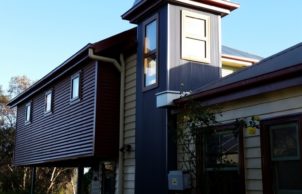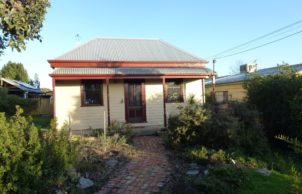Turret House
Turret House
The Turret House began as a humble 19th century miner’s cottage comprising two hip roof sections and a skillion section at the rear. In approximately 1990, the skillion section was demolished and a new hip roof section was added comprising an open plan kitchen/living room oriented towards the backyard, and a bathroom, laundry and toilet.
When we purchased the property in 2003, the house had three small bedrooms and an overall floor area of approximately 118 m2. Although the open plan kitchen/living room had a nice outlook towards the backyard, the windows were oriented towards the west and south. Thus, it was dull and we often needed lights and heating on during the daytime, even on sunny days.
Over the years, we have progressively renovated and improved the house and garden, with a vision of creating a sustainable and comfortable family home. When the electric hot water service rusted out in 2008, we replaced it with a gas boosted solar evacuated tube system. When BREAZE organised a solar neighbourhood program, we quickly signed up to install a 1 kW grid integrated solar PV system. We have three above‑ground water tanks with a total volume of 23,000 litres. The tanks are connected to the house, so when the water is not required for garden use they can reduce our dependence on town water.
Following the addition of two little people to our family, we began to feel the squeeze in our little house, particularly our cottage sized main bedroom. In 2014, we embarked upon an extension at the rear with the multiple aims of improving livability, maximising sustainability features, maximising solar access, minimising the footprint on our treasured backyard, minimising overshadowing of our existing barbeque area and retaining as much of the existing house as possible (only demolished the rear verandah and two external walls; re-used existing windows and doors).
In summary, we now have a very comfortable family home, largely due to its sustainability features which include:
- Great solar access, with lots of north-facing windows and a skylight in the kitchen;
- Shading to north-facing windows on the first floor of the new extension;
- Double glazing to all new windows and doors;
- A door at the bottom of the staircase, to avoid heat loss from ground floor living area to first floor bedroom during cooler months.
- Ceiling insulation: R6.0 Earthwool batts in the new extension area. R6.0 polyester batts in the older area;
- Wall insulation: R2.5 Earthwool batts plus wall wrap in the new extension area. Wall wrap in the older area;
- Sub-floor insulation to ground floor and first floor: R2.5 Masterfloor polystyrene boards;
- Two turbo roof ventilators, one on the ground floor and one on the first floor;
- Good cross-flow ventilation via the long east-west axis of the house;
- Energy efficient LED lighting and ceiling fans throughout most of the house;
- Rainwater tanks with a total volume of 23,000 litres, connected to the house;
- Some reclaimed doors and windows in the new extension;
- Recycled hardwood floorboards in the new extension;
- Five star gas central heating, with insulated ducts and zone control;
- Native garden;
- Vegetable garden under development.




Ask questions about this house
Load More Comments